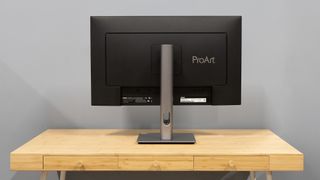If producing high-resolution art is your thing, whether it moves or not, then a high-res monitor with good colour reproduction is an essential part of your desk setup. Apple knows this, and will sell you its Studio Display – 5K at 27 inches – for £1,500/$1,600 before you start adding extras. ASUS, known for its gaming monitors and ProArt laptops, has disrupted this marketplace with a new 5K/27-inch screen that comes in at a much lower price and is going to be very attractive to anyone kitting out their studio. Attractive enough to make it to the top of our list of the best monitors for graphic design? Maybeeeee.

Design & build
While the 17-inch CRT Apple Studio display resembled an iMac’s tripodal alien mother come to take revenge on Earthlings for their dreadful treatment of her offspring, the advent of flatscreens has rather curtailed the excesses of tech companies’ design departments.
So it is with the ProArt monitor. It’s not bad-looking by any means, it just looks like every other monitor out there right now. You’d never tell from looking at it just how many pixels have been squeezed into its slim chassis, how its black bezels creak under the pressure of keeping such high resolution in check.
What you can immediately see, however, are the design decisions that have led to the OSD having buttons that are on the front of the frame where you can actually get to them, rather than being hidden around the back or on the edge. There are multiple switches alongside a joystick, making it comfortable to adjust things like brightness or put it into a different display mode.

Screen size: 27in
Screen type: IPS Black, LED backlight
Resolution: 5120×2880
Colour gamut (stated): 100% sRGB
Inputs: 1x HDMI 2.1, 1x DisplayPort 1.4, 2x USB-C, 3x USB-A, headphones
HDR: HDR10, DisplayHDR 500
Webcam: no
Features: USB KVM, VRR adaptive sync, 96W power delivery
Speakers: 2x 2W
Dimensions: 61.22 x 53.81 x 21.50 cm
Weight: 5.91kg
There’s also no power brick – a simple kettle lead plugs straight into the back of the screen, which makes the floor under your desk slightly less untidy. There’s an on/off switch next to this too, if you need to deactivate the screen for any reason. And the input array comes with a guide moulded into the plastic of the casing, so you don’t spend time squinting and twisting the screen when you try to plug something in. These are all excellent things.
The stand is a slightly unusual one, coming in three pieces and making use of a plastic latch to secure the vertical leg into the plate that attaches to the screen’s VESA mount. This then attaches to the foot with a single thumb-turned screw. It’s easy enough to put together, though the white plastic of the latch does look like it could break easily if you put pressure on it – not something you’re going to be doing to a monitor, hopefully. Once assembled, it’s highly adjustable, with 130mm of height change and enough pivot to turn the monitor through 90° for accessibility purposes or because you want a high-res portrait display.

Features & performance
Obviously, 5K is a lot of resolution for a 27-inch screen. Monitors of this size are more usually 1080p or 1440p, with the occasional budget 4K model thrown in. The resolution we’re probably supposed to be calling 2880p offers a much higher pixel density – 218ppi here, which isn’t as high as that of a modern iPhone but looks great spread across a screen this size and is 2.5 times as dense as an HD display. That’s basically the same as the Apple Studio Display, which is also a 27-inch, 60Hz panel, though this one does HDR.

The ProArt comes with various colour presets aimed at the different gamuts. In its native mode, you can expect 100% sRGB, 86% Adobe RGB and 97% P3, and you’ll be able to fine-tune that response by selecting the appropriate preset or doing a complete custom calibration with the two user modes. Brightness isn’t bad, at 380 nits, and there’s a power-saving warning that prevents you from going over 50% brightness without confirming that you really want to do it.
There’s a good spread of inputs along the back edge of the ProArt, with HDMI 2.1 and DisplayPort 1.4 alongside a USB-C connector that supplies 96W of power to charge your laptop while it’s connected. The USB KVM is supplied via a second USB-C socket rather than the more usual USB-B, which is convenient and keeps things a bit tidier on the back, and 3x USB 3.2 Gen 1 Type-A ports allow you to share quite a few peripherals between two computers.

Price
At the time of writing, the retail price of the ASUS ProArt Display PA27JCV was a little hard to pin down, but we expect it to sell for somewhere in the $800/£800 range. This is excellent value for such a screen, undercutting the Apple Studio Display and coming in at considerably less than pro-grade monitors from multiple manufacturers, with 4K OLED screens proving much more expensive. It may be a niche product, but that doesn’t mean it’s priced itself out of the market.
Who is it for?
There’s very little reason to get a 5K screen unless you need the high-res visuals. Gamers will look for a higher refresh rate, and most play games at 1080p or 1440p anyway. While 5K is a good choice for video editing, the refresh rate may become a limit there too. It is, however, an absolutely beautiful screen for photo editing and graphic design, which is where we expect the majority of its users to come from.
Buy it if…
- You want a high resolution
- You want good colour response
- You don’t need a high refresh rate
Don’t buy it if…
- You want a gaming monitor
- You want an OLED
- You don’t need 5K
Also consider
Worth the investment if you’re a fully paid-up Apple fan, but still only 60Hz.
The mini-LED backlight gives this 27in 1440p screen incredible brightness and contrast, and it’s 180Hz too.
A pro-grade 32in 4K IPS monitor with good colour reproduction, but can be even more costly than the Apple screen.



